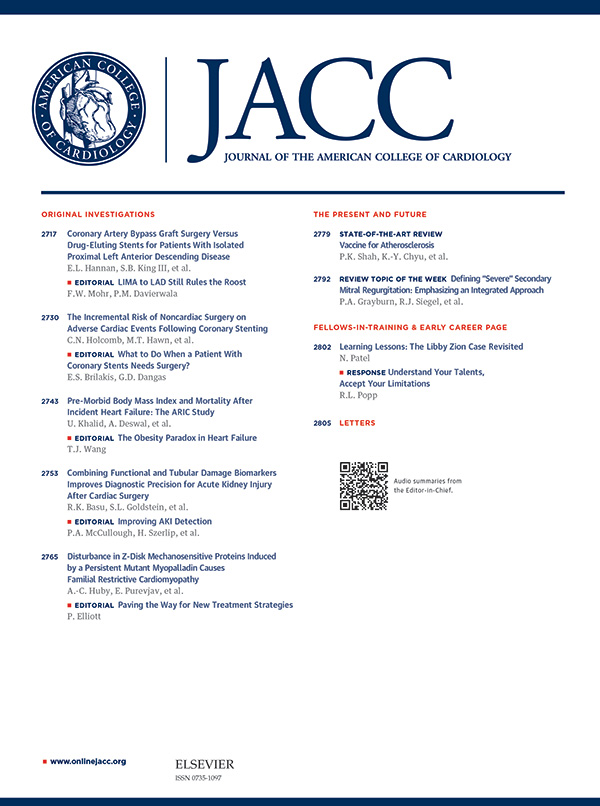Impact of Body Mass Index, Central Adiposity, and Weight Loss on the Benefits of Tirzepatide in HFpEF
IF 21.7
1区 医学
Q1 CARDIAC & CARDIOVASCULAR SYSTEMS
引用次数: 0
Abstract
Background
The SUMMIT trial showed that the long-acting glucose-dependent insulinotropic polypeptide receptor and glucagon-like peptide 1 receptor agonist tirzepatide decreased the risk of cardiovascular death or worsening heart failure (HF) in patients with obesity-related heart failure with preserved ejection fraction (HFpEF). Effects may differ by baseline obesity severity, distribution, or magnitude of weight loss.
Objectives
In this analysis, the authors compared baseline characteristics and effects of tirzepatide on primary and other endpoints according to baseline obesity severity and distribution, and we explored relationships between degree of weight loss achieved and outcomes.
Methods
In the SUMMIT trial, 731 patients with NYHA functional class II-IV HFpEF and body mass index (BMI) ≥30 kg/m2 were randomly assigned to tirzepatide (n = 364) or placebo (n = 367). The primary outcomes were time to cardiovascular death or worsening HF and change in Kansas City Cardiomyopathy Questionnaire Clinical Summary Score (KCCQ-CSS) at 52 weeks. Key secondary outcomes included changes in 6-minute walk distance (6MWD), C-reactive protein (CRP), and body weight (BW) at 52 weeks. In this secondary analysis, primary and secondary endpoints were analyzed based on obesity severity (BMI) and distribution (waist-height ratio [WHR]). Time-to-event endpoints were analyzed with the use of a Cox regression model, and continuous endpoints were assessed with the use of a mixed-effects model for repeated measures. Relationships between changes in BW and waist circumference (WC) on treatment with tirzepatide and changes in key endpoints also were evaluated.
Results
Patients with obesity-related HFpEF and higher BMI were younger and more likely to be female, with more severe HF symptoms and physical limitations, greater volume expansion despite higher diuretic use and lower natriuretic peptide levels, and more severe systemic inflammation compared with patients with lower BMI. These findings were largely similar when contrasting patients by baseline WHR, but those with higher WHR also had poorer exercise capacity and more severe kidney disease. There was no evidence of heterogeneity in the effect of tirzepatide on the risk of worsening HF or cardiovascular death by BMI or WHR tertile. However, with increasing tertiles of baseline BMI, there were greater improvements in 6MWD (estimated treatment difference [ETD]: 9.9 vs 26.3 vs 37.5 m; P = 0.025), and greater decreases in BW (ETD: −10.7% vs −11.8% vs −14.4%; P = 0.006) and systolic blood pressure (ETD: −1.00 vs −6.65 vs −6.62 mm Hg; P = 0.035) with tirzepatide compared with placebo, with a trend for greater improvement in KCCQ-CSS (P = 0.097). Among those randomized to tirzepatide, greater weight loss at 52 weeks was associated with larger improvements in 6MWD, KCCQ-CSS, CRP, and blood pressure, and a greater decrease in WC was associated with larger increases in 6MWD and KCCQ-CSS. Patients with elevated WHR but lower BMI had higher NYHA functional class and N-terminal pro–B-type natriuretic peptide, poorer kidney function, and lower 6MWD compared with those with lower WHR but higher BMI.
Conclusions
Among patients with obesity-related HFpEF, greater BMI is associated with younger age, female sex, more volume overload and inflammation, and more severe HF, and those with greater WHR also showed greater impairment in kidney function and exercise capacity. Tirzepatide consistently reduced the risk of HF or cardiovascular death regardless of baseline BMI, but there was evidence suggesting greater improvement in 6MWD in those with higher BMI at baseline. Greater weight loss on treatment with tirzepatide was associated with greater improvements in 6MWD and KCCQ. (A Study of Tirzepatide [LY3298176] in Participants With Heart Failure With Preserved Ejection Fraction [HfpEF] and Obesity [SUMMIT]; NCT04847557)

体重指数、中心性肥胖和体重减轻对替西肽在HFpEF中获益的影响:SUMMIT试验
SUMMIT试验显示,长效葡萄糖依赖性胰岛素性多肽受体和胰高血糖素样肽1受体激动剂替西肽可降低具有保留射血分数(HFpEF)的肥胖相关性心力衰竭患者心血管死亡或心衰(HF)恶化的风险。效果可能因基线肥胖严重程度、分布或体重减轻幅度而异。在本分析中,作者根据基线肥胖严重程度和分布比较了替西肽的基线特征和对主要终点和其他终点的影响,并探讨了体重减轻程度与结果之间的关系。方法在SUMMIT试验中,731例NYHA功能级II-IV级HFpEF且体重指数(BMI)≥30 kg/m2的患者被随机分配到替西肽组(n = 364)或安慰剂组(n = 367)。主要结局是心血管死亡或心衰恶化的时间,以及52周时堪萨斯城心肌病问卷临床总结评分(KCCQ-CSS)的变化。主要次要结局包括52周时6分钟步行距离(6MWD)、c反应蛋白(CRP)和体重(BW)的变化。在这项次要分析中,主要和次要终点根据肥胖严重程度(BMI)和分布(腰高比[WHR])进行分析。使用Cox回归模型对事件时间终点进行分析,使用混合效应模型对重复测量的连续终点进行评估。还评估了替西肽治疗后体重和腰围(WC)变化与关键终点变化之间的关系。结果肥胖相关HFpEF和高BMI患者更年轻,更可能是女性,与低BMI患者相比,HF症状和身体限制更严重,尽管利尿剂使用较多,利钠肽水平较低,但体积扩张更大,全身性炎症更严重。当以基线腰宽比对比患者时,这些发现在很大程度上是相似的,但腰宽比高的患者运动能力更差,肾脏疾病更严重。没有证据表明替西肽对心衰恶化或心血管死亡风险的影响存在异质性。然而,随着基线BMI的增加,6MWD的改善更大(估计治疗差异[ETD]: 9.9 vs 26.3 vs 37.5 m;P = 0.025),体重下降幅度更大(ETD: - 10.7% vs - 11.8% vs - 14.4%;P = 0.006)和收缩压(ETD: - 1.00 vs - 6.65 vs - 6.62 mm Hg;P = 0.035), KCCQ-CSS有更大改善的趋势(P = 0.097)。在随机接受替西肽治疗的患者中,52周体重减轻幅度越大,6MWD、KCCQ-CSS、CRP和血压的改善幅度越大,WC下降幅度越大,6MWD和KCCQ-CSS的增加幅度越大。WHR升高而BMI较低的患者与WHR较低而BMI较高的患者相比,NYHA功能分级和n端前b型利钠肽较高,肾功能较差,6MWD较低。结论在肥胖相关HFpEF患者中,BMI越高,年龄越小,性别越女性,体积负荷和炎症越严重,HF越严重,WHR越大,肾功能和运动能力受损越严重。无论基线BMI如何,替西帕肽均可降低HF或心血管死亡的风险,但有证据表明,基线BMI较高的患者6MWD有更大的改善。替西肽治疗的体重减轻与6MWD和KCCQ的改善相关。替西帕肽[LY3298176]对保持射血分数[HfpEF]和肥胖[SUMMIT]的心力衰竭患者的治疗研究NCT04847557)
本文章由计算机程序翻译,如有差异,请以英文原文为准。
求助全文
约1分钟内获得全文
求助全文
来源期刊
CiteScore
42.70
自引率
3.30%
发文量
5097
审稿时长
2-4 weeks
期刊介绍:
The Journal of the American College of Cardiology (JACC) publishes peer-reviewed articles highlighting all aspects of cardiovascular disease, including original clinical studies, experimental investigations with clear clinical relevance, state-of-the-art papers and viewpoints.
Content Profile:
-Original Investigations
-JACC State-of-the-Art Reviews
-JACC Review Topics of the Week
-Guidelines & Clinical Documents
-JACC Guideline Comparisons
-JACC Scientific Expert Panels
-Cardiovascular Medicine & Society
-Editorial Comments (accompanying every Original Investigation)
-Research Letters
-Fellows-in-Training/Early Career Professional Pages
-Editor’s Pages from the Editor-in-Chief or other invited thought leaders

 求助内容:
求助内容: 应助结果提醒方式:
应助结果提醒方式:


